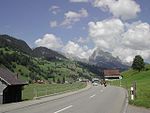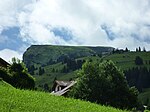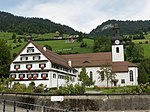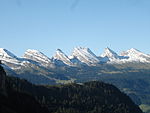Schwendisee
Schwendisee is a small lake above Wildhaus on the slopes of the Churfirsten, in Toggenburg, Canton of St. Gallen, Switzerland. Besides the main lake (Vorderer Schwendisee), there is a smaller lake nearby (Hinterer Schwendisee). Sediment cores from the lakes have been studied and provide a record of the climate of the last 600 years.Schwendisee is a combination of two words - ‘Schwendi’ and ‘see’ where Schwandi refers to the glacier that melted about 1,400 years ago to form the lakes and ‘see’ translates to lake in English. The elevation of the lake is about 1,150 metres above sea level. Schwendisee is nestled in moorland where the waterbody is divided into the front Schwendisee and the rear Schwendisee separated by strip of forest. The larger Vorderer Schwendisee is open to visitors for fishing, swimming and hiking. It is about 250m long and 150m wide. A broadwalk extends to the middle of the lake to allow visitors to enter the water. Both lakes are surrounded by dense reeds and marshes and also have small creeks feeding the flora. Visitors can find barbeque facilities at either side of the lake and the Hotel Seegüetli on the northern end of the lake.
Excerpt from the Wikipedia article Schwendisee (License: CC BY-SA 3.0, Authors).Schwendisee
Hinderseenstrasse, Wildhaus-Alt St. Johann Lisighaus
Geographical coordinates (GPS) Address Nearby Places Show on map
Geographical coordinates (GPS)
| Latitude | Longitude |
|---|---|
| N 47.187 ° | E 9.331 ° |
Address
Hinderseenstrasse
9658 Wildhaus-Alt St. Johann, Lisighaus
St. Gallen, Switzerland
Open on Google Maps










